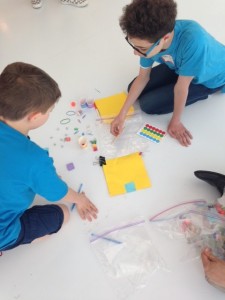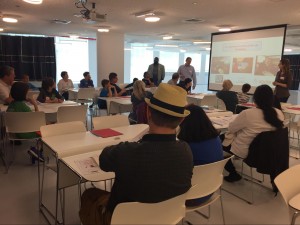Several years ago, Museum of the Moving Image presented an exhibition called Spacewar! Video Games Blast Off. This was nothing new for us. We had done exhibitions about video games, featuring playable games in the Museum’s galleries, many times before–we presented our first such exhibition, Hot Circuits: A Video Arcade, a year after we opened in 1989–and video games have been featured in our core exhibition for nearly a decade. But Spacewar was notable, in part, for commemorating the 50th anniversary of what is often called the first video game.

For the Museum’s Education department, the exhibition became an occasion to take stock and rethink how we teach with and about video games with students, teens, teachers, parents, and grandparents. As educators, we often work under the assumption that kids are interested in games, but adults are skeptical of them. But now that video games have passed their 50th birthday, maybe it’s time to rethink that assumption. After all, teachers, parents, and increasingly grandparents, have grown up with video games, just as today’s young people have. With that in mind, maybe the Museum space can activate a shared interest and appreciation: by looking at games historically and taking the form seriously, our programs can bring young people and adults together through games.
When E-Line Media and the Joan Ganz Cooney Center contacted us on behalf of AARP and Mentor Up as a potential host for an intergenerational game design workshop for young people (ages 10+) and the older adults (ages 50+) in their lives, we jumped at the opportunity. This was an extension of the work we were already doing, and we were eager to see what an intergenerational game design workshop might look like at the Museum. We offered just one non-negotiable: the Museum had to be more than just a venue. Since we have some of the most significant games from the 1970s and 1980s on exhibit in the galleries, we wanted to incorporate the playing of historic games into the workshop design. Doing so seemed like a natural way of bringing multiple generations of game players together while also underscoring a key idea we wanted the participants to walk away with–that the principles we would ask them to think about in the workshop related to systems and design thinking are fundamental to how games work, whether the reference point is Ms. Pac-Man or Minecraft.
As we finalized the details of the workshop, we began our outreach efforts. Having never done an intergenerational program quite like this before, we decided to activate all of the networks we thought might have some interest, including teachers and administrators at our partner schools, colleague organizations who also do work with youth and digital media, the Museum’s family-level members, alumni from our Summer Media Camp game design programs, and, of course, the general public via the Museum’s printed marketing materials, website, and social media platforms. We were delighted to find that the workshop filled up almost immediately, with a huge level of excitement expressed from the registrants. We quickly switched over to a waitlist to deal with the overwhelming interest. As we prepared for the workshop, we also began studying the enrollment patterns: While the program was open to to youth ages 10-18, we only had participants in the 10-12 age range; additionally, about half of the older adults were parents rather than grandparents.

Last Sunday, we had a capacity crowd turn up for the workshop. The facilitators from E-Line and the Cooney Center had a clear vision for how the three hours would unfold. After an ice breaker, participants were introduced to some basic trends in game design, which challenged assumptions about who plays games, who makes them, and why. Then the conversation moved into game design terminology, and games as playful systems. Exploring games as systems was a crucial first step, both in starting to identify the similarities between some of the games the older adults mentioned liking (Scrabble, Othello, cards) and the games the young people called out (Pokemon, Minecraft, Super Smash Brothers) as well as transitioning into the actual game design activity. Pairs teamed up into small groups. Some went into the galleries to play and think about historic games, and the rest were each given a grab bag of random objects such as pipe cleaners, stickers, and even a few pieces of candy to make an analog game, then try out the other games. This experience introduced the concept of playtesting—an important step for any designer, and an opportunity to learn from the group. After a round, the groups switched between the galleries and the analog design activities. When everyone had visited the Museum and made an analog game, they transitioned into digital game-making using Gamestar Mechanic.
As is often the case with these sorts of workshops, the primary complaint from participants was that there just wasn’t enough time. Participants left with the log-in and account info they needed to keep working on their games on their own, though, and they were clearly brimming with ideas about what they wanted to do next. We were particularly inspired by a grandmother-grandson pair. The grandmother was visiting from Oregon, and on the way out of the workshop, she enthusiastically mentioned that she would be setting up her own log-in so that she and her grandson could continue what they’d started at the Museum—her from the West Coast, him in New York.
Such success stories point the way towards future programming exploring the intergenerational appeal of game design. Our collaboration with E-Line Media, the Cooney Center, and Mentor Up also introduced us to another organization offering programs in this space that takes a pedagogical approach similar to our own. As this community of organizations and instructors continues to grow, we are excited to engage in further dialogue with Mentor Up and other like-minded colleagues to develop, refine, and share best practices for game design programming for wide-ranging and diverse audiences.
 Jordan Smith is Manager of Education Programs at Museum of the Moving Image, where she oversees the Museum’s informal learning programs including after-school and summer classes, family programs, teen programs, and partnerships. She holds a BA in Education from Smith College and an MA in Cinema Studies from New York University. Her favorite game is Yahtzee.
Jordan Smith is Manager of Education Programs at Museum of the Moving Image, where she oversees the Museum’s informal learning programs including after-school and summer classes, family programs, teen programs, and partnerships. She holds a BA in Education from Smith College and an MA in Cinema Studies from New York University. Her favorite game is Yahtzee.
 Chris Wisniewski is Deputy Director for Education & Visitor Experience at Museum of the Moving Image, where he manages all of the Museum’s educational programs for students, teachers, children, teens, families, adults, and seniors, as well as its online educational activities. He also oversees the Museum’s internship and volunteer programs, as well as admissions and ticketing. He holds a BA in Social Studies from Harvard University and an MA in Cinema Studies from New York University. His favorite game is Backgammon.
Chris Wisniewski is Deputy Director for Education & Visitor Experience at Museum of the Moving Image, where he manages all of the Museum’s educational programs for students, teachers, children, teens, families, adults, and seniors, as well as its online educational activities. He also oversees the Museum’s internship and volunteer programs, as well as admissions and ticketing. He holds a BA in Social Studies from Harvard University and an MA in Cinema Studies from New York University. His favorite game is Backgammon.


